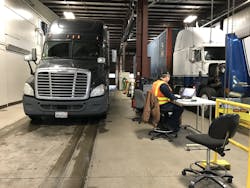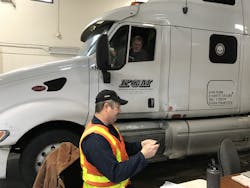Abe Dunivin waves the tractor-trailer into an inspection bay at the weigh station on Interstate 5 in Woodburn, OR. It’s something Oregon inspectors do thousands of times each year, but it has been different since December 18, 2017. “Every time, I discover something new,” said Dunivin, technical service coordinator with the motor carrier division of the Oregon Dept. of Transportation (ODOT).
His comment reflects a new reality facing commercial drivers and inspectors since implementation of the Federal Motor Carrier Safety Administration’s (FMCSA’s) electronic logging device (ELD) mandate. “We have received lots of training on how devices are supposed to work, but I wonder if [FMCSA] ever realized all the differences among all the varieties,” he said.
Dunivin invited me to observe inspections at Oregon’s busiest weigh station, located 30 miles south of Portland. During the first inspection, Brent Watts of United Road Services removes his tablet device from the cradle to show it to Dunivin, who instead requests the data be e-mailed. “The less handling of [their] device the better,” Dunivin told me.
After several failed e-mail attempts by Watts, he makes a discovery—it appears the tablet must be reattached and restarted in order to send e-mails. As Dunivin reviews the data at a nearby desk, Watts said this is his first ELD inspection. The transition to ELDs a year ago was a “fairly straightforward” process, but he finds he has to reboot the device too often.
Watts also mentioned that a few times, several hours had passed before he realized the device failed to automatically switch to on-duty time. A more serious situation played out 90 minutes later, when a truck with California license plates pulled in. The driver, who asked not to be identified, had an ELD but could not log in. Neither could his co-driver, who remained out of sight in his sleeper.
They told Dunivin they just received training, and this is their first time on the road with an ELD. They claimed it had been working the day before and provided paper logs documenting the past eight days. After a 20-minute review of the logs, fueling receipts, and weigh station data, Dunivin determined there appeared to be no malice on the drivers’ part.
Because this happened during the “soft enforcement” period (prior to April 1), Dunivin wrote a warning citation that will not affect their Compliance, Safety, Accountability (CSA) scores. There will not be any financial penalties, provided the carrier acknowledges receiving the citation within 15 days. Before they drove off, Dunivin reminded them that after April 1, he would be forced to place them out of service for not using an ELD.
To Dunivin, those examples illustrated why it would have been a good idea to extend the soft enforcement period.
But Collin Mooney, executive director of the Commercial Vehicle Safety Alliance, opposed any suggestion of pushing out the April 1 date. “You can’t say this is new or a surprise,” Mooney said of the mandate.
He took issue with my use of the phrase “soft enforcement” when asked how the first month had gone since the implementation date. “Overall, I would say things are going reasonably well,” Mooney said. “It’s as good as it could be when implementing a new rule.”
He added the mandate “does add a degree of difficulty,” but it is the responsibility of truckers and fleets to educate themselves—whether they are using an ELD or older automatic onboard recording device (AOBRD). AOBRDs are allowed until December 2019 and generally have less functionality and electronic capabilities than the latest ELD models.
“Knowing that answer would do a world of good and streamline the inspection process,” Mooney said.
Preparing inspectors for every possibility has been the focus of Officer Jeremiah N. Marceau, a Washington State Patrol commercial vehicle enforcement officer. Early this year, he was heading up efforts to train about 100 inspectors across the state on the mandate. Using information from FMCSA’s National Training Center, his eight-hour class features an overview of hours-of-service rules and the rule differences with AOBRDs and ELDs. Inspectors are walked step-by-step through the ELD inspection process, including what truck drivers are required to know.
Marceau stressed “none of the [HOS] rules have changed. This is the same thing we have enforced for years. It just is now a uniform way to look at it.”
Frank Riordan, president of Becker Trucking near Seattle, knows his 60 drivers will be ready if they come into contact with law enforcement. Becker has used PeopleNet’s ELDs for four years and spent considerable time “preparing our drivers for December 18,” said Riordan, who is also president of the Washington Trucking Associations. He said experienced truckers joining the company spend about five days with a driver trainer. A newer driver gets 30 days of close oversight with a trainer, including extensive ELD practice.
Tim Rhoades, manager of Becker’s Portland terminal, said there are still incidents where drivers do not do everything correctly, requiring carefully documented manual corrections.
During a visit to the Portland terminal, Rhoades, dispatcher Eric Thompson, and driver Greg Anuskewicz all said they believed ELDs had made their jobs easier and safer. When asked how a driver should respond if facing a time crunch, Rhoades responded “the right thing is to run over” to find a safe parking spot, reach the next town, or make it back to home base.
On occasions when there have been more extensive traffic or unloading delays, Becker has sent out a second truck with two drivers in order to legally bring that driver and vehicle home, Rhoades said.
Dave McKane, safety manager of the Motor Carrier Transportation Division of ODOT, said he “hopes most officers and inspectors would be reasonable” — while also suggesting to me that may not be the same thing as what a trucker may view as “fair.”
Reasonable was also the word used by Dunivin numerous times. “This is a growing process, and we need to be patient,” he said. “[Inspectors] should try to be reasonable because there are going to be situations where the driver might be a few minutes over [hours] for things out of their control.”
He urged truckers in these cases not to switch into personal conveyance mode in an effort to elude detection of an HOS violation. If caught, that brings with it a more severe penalty.
Meanwhile, CVSA’s Mooney said he was “disappointed” with some portions of the trucking industry for making the transition to ELDs more difficult. He was critical of those who waited until the December 18 deadline to begin purchasing ELDs because they hoped there would be a last-minute change to the regulation.
Additionally, he expressed frustration with some truckers who “have installed ELDs to meet the regulatory language yet are still running paper logs.” He said he believes this group had been taking advantage of the pre-April window.
The high number of requests for exemptions and waivers being sought throughout the transportation industry was another point of concern for Mooney.
“The volume of exemptions … is going to be problematic,” he said, adding that these raise the chances of mistakes or confusion among truckers and law enforcement. “This can complicate the whole inspection process,” he warned.
During the same week Fleet Owner observed the Oregon inspections, FMCSA granted an exemption to Old Dominion Freight Line and other fleets having problems integrating PeopleNet’s ELD software into management systems.
Bryan Coyne, senior vice president of PeopleNet, said some fleets need extra time to make sure the software cooperates with existing back office systems.
Old Dominion said it was transitioning to PeopleNet’s latest software, released in December, and has been using PeopleNet AOBRDs and ELDs in its entire fleet since 2011. In mid-February, FMCSA also granted short-term waivers for eight J.J. Keller ELD models because of a software problem that prevents proper transmission of data to roadside enforcement.
FMCSA said the waivers would not impact safety, but Dunivin said every exemption or waiver has the possibility to add complexity and confusion to the inspection process. He also said age is playing a role in how individuals view the mandate.
“The younger generation is picking up on it pretty quickly,” said Dunivin, adding that applies both to drivers and inspectors. “Drivers who have been using it a while … seem to love [ELDs]. I have not come across one who has had one for a while who says they don’t like it. It is the unknown [of ELDs] in this other population of people. They are not as tech savvy.”
He compared the current ELD landscape to smartphones. While many may have resisted purchasing one when they first came out, only a very small percentage of people, including truckers, do not currently own one.
“We are all going through some growing pains,” he said. “It will smooth out and get better eventually.”
About the Author
Neil Abt
Neil Abt is a former FleetOwner editor who wrote for the publication from 2017 to 2020. He was editorial director from 2018 to 2020.


